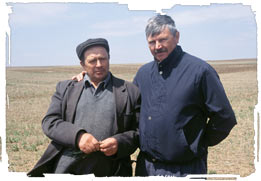CIMMYT E-News, vol 2 no. 11, November 2005
 Kazakhstan and Siberia connect with CIMMYT to improve their wheat.
Kazakhstan and Siberia connect with CIMMYT to improve their wheat.
Grigoriy Sereda, Head of the Breeding Department at the Central Kazakhstan Agricultural Research Center, is nothing if not direct. “The future of our breeding program relies on KASIB. Without it, germplasm exchange would be nonexistent. And without germplasm exchange, crop breeding cannot move forward.”
KASIB, the Kazakhstan-Siberia Network for Spring Wheat Improvement, was established in 2000 as the brainchild of CIMMYT regional representative Alexei Morgounov. In the former Soviet Union, there was considerable seed exchange among the republics and interactions among breeders and crop research institutes. But after the break-up of the U.S.S.R., many scientists found themselves isolated professionally and with little access to breeding lines from outside sources. Through KASIB, CIMMYT, with modest funding from GTZ, a German development agency, and the International Cooperation for Agricultural Research in Central Asia and the Caucasus, endeavored to rectify the situation
The principles of the network are simple: participants share breeding lines and data and abide by a Wheat Workers Code of Ethics (a declaration by the U.S. National Wheat Improvement Committee). Aside from active exchange and evaluation of experimental lines, the network publishes trial results and proceedings from an annual meeting where scientists from participating institutions present and discuss their work.
Each of the 17 participating institutions submits 2-4 recent varieties or breeding lines to CIMMYT’s Kazakhstan office, where seed for the trials and the field books are prepared and distributed to cooperators in April, prior to planting. The trials are grown at the diverse sites with three replications. Data from trials are submitted to CIMMYT, where they are summarized, published in Russian and English, and distributed to cooperators and others. The trials are a key source of lines and varieties carrying important traits such as drought tolerance, disease resistance (primarily to leaf rust and septoria leaf blotch), and improved grain quality.
 Illustrating the point, in 2000 northern Kazakhstan and Siberia suffered a leaf rust outbreak, Morgounov recounts. None of the 80 modern varieties and lines being tested showed resistance to the pathogen. This clearly indicated a pressing need for the breeders to address, and one for which CIMMYT was well equipped to assist.
Illustrating the point, in 2000 northern Kazakhstan and Siberia suffered a leaf rust outbreak, Morgounov recounts. None of the 80 modern varieties and lines being tested showed resistance to the pathogen. This clearly indicated a pressing need for the breeders to address, and one for which CIMMYT was well equipped to assist.
Another facet of KASIB is an innovative shuttle breeding program between the network and CIMMYT-Mexico. Following several years of trials, says CIMMYT wheat breeder Richard Trethowan, scientists in the network select elite local lines and varieties with promising agronomic or quality traits and send seed to Mexico to be crossed with CIMMYT materials that possess leaf rust resistance and other locally-desirable traits, such as a tall profile and photoperiod sensitivity. The lines are crossed with a Kazakh parent or to another Kazakh or Canadian line and returned to Kazakhstan and Siberia for additional breeding to ensure adaptation to local environments.
Once adapted, Trethowen continues, the line can then be sent back to Mexico for further crossing and improvement, hence the term shuttle. The system not only allows incorporation of traits not found in the region’s wheat, but accelerates breeding by allowing multiple cycles per year. The first full cycle of the shuttle was completed in 2004, with the first advanced lines reaching Mexico. Trethowen credits KASIB for enabling the approach to be applied in Central Asia and for benefits that accrue to CIMMYT wheat research through the added genetic diversity introduced from Kazakh and Siberian lines—diversity that may well serve farmers elsewhere in the developing world.
For Sereda, KASIB has breathed fresh life into his work: for example, he has received more than 200 entries to plant through the network and has selected about 60 for crosses. He is particularly enthused about the experimental wheats from CIMMYT’s wide-cross research—derived from crosses with wild relatives of wheat—received through the KASIB-CIMMYT shuttle. After 35 years of plant breeding, the wide-cross collection brings an entirely new tool on which to focus his vast experience. And he thanks KASIB meetings and publications for providing a forum to share his knowledge and more quickly move improved wheats to the farmers of Kazakhstan.
For further information, contact Alex Morgounov (a.morgounov@cgiar.org).
 Capacity development
Capacity development